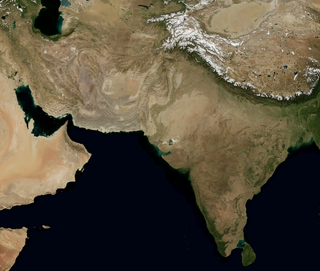
The Geography of Pakistan encompasses a wide variety of landscapes varying from plains to deserts, forests, and plateaus ranging from the coastal areas of the Indian Ocean in the south to the mountains of the Karakoram, Hindukush, Himalayas ranges in the north. Pakistan geologically overlaps both with the Indian and the Eurasian tectonic plates where its Sindh and Punjab provinces lie on the north-western corner of the Indian plate while Balochistan and most of Khyber Pakhtunkhwa lie within the Eurasian plate which mainly comprises the Iranian Plateau.

The Ravi River is a transboundary river crossing northwestern India and eastern Pakistan. It is one of five rivers associated with the Punjab region.

Doab is a term used in South Asia for the tract of land lying between two confluent rivers. It is similar to an interfluve. In the Oxford Hindi-English Dictionary, R. S. McGregor defines it as from Persian do-āb "a region lying between and reaching to the confluence of two rivers."

The Jhelum River is a river in the northern Indian subcontinent. It originates at Verinag and flows through the Indian-administered territory of Jammu and Kashmir, into Pakistani-administered Azad Kashmir, then the Pakistani province of Punjab. It is the westernmost of the five rivers of the Punjab region, and flows through the Kashmir Valley. It is a tributary of the Chenab River and has a total length of about 725 kilometres (450 mi).

Jhang is the capital city of Jhang District in central Punjab, Pakistan. Situated on the east bank of the Chenab river, it is the 18th largest city of Pakistan by population.
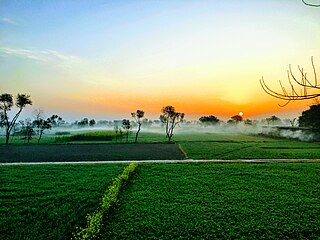
Jhang District is a district of Faisalabad division in the Punjab province, Pakistan. Jhang city is the capital and administrative seat of district.
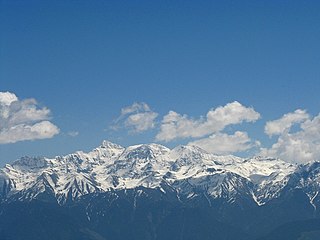
The Pir Panjal Range is a range of mountains in the Lower Himalayan region located in the Western Himalayas of northern Indian subcontinent. It runs southeast to northwest between the Beas and Neelam/Kishanganga rivers, in the Indian state of Himachal Pradesh and Indian-administered union territory of Jammu and Kashmir, with its northwestern end extending into territory administered by Pakistan. The Himalayas show a gradual elevation towards the Dhauladhar and Pir Panjal ranges. Pir Panjal is the largest and westernmost range of the Lesser Himalayas. Near the bank of the Sutlej River, it dissociates itself from the main Himalayan range and forms a divide between the Beas and Ravi rivers on one side and the Chenab on the other. Further west, the Pir Panjal range forms the southwestern boundary of the Kashmir Valley, separating it from the hills of Jammu region, forming a divide between the Jhelum and Chenab rivers.

Sheikhan town is situated in Chiniot Tehsil and in District Chiniot in Punjab province of Pakistan.

The Sandal Bar is a region between the rivers Chenab and Ravi in Punjab, Pakistan.

Shorkot, , is a city in Punjab, Pakistan.
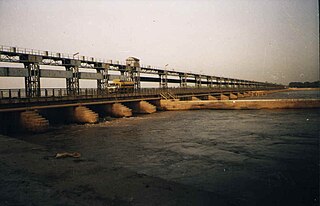
Trimmu Barrage is a barrage on the River Chenab in the Jhang District of the Punjab province of Pakistan. It is situated downstream of the confluence of the River Jhelum and River Chenab. It is situated some 25 km from the city of Jhang near the city of Atharan Hazari where the River Jhelum flows into the River Chenab. It was one of the 7 link canals to be built under the Indus Water Plan of Pakistan. Pakistan created this plan after Indus Water Treaty
Barana is a union council of Lalian tehsil in Chiniot District, Punjab province, Pakistan.
Hassu Balail is a town of Tehsil Shorkot Tehsil in Jhang District of Punjab province of Pakistan. The town is located near the River Chenab after the River Jhelum merges with this river. The town is located on the Jhang-Layyah, Jhang-Multan Road going to Jhang Sadar. Parco pumping station is near this town.

The Thal desert is situated at 31°10’ N and 71°30’ E in the province of Punjab, Pakistan. Located near the Pothohar Plateau, the area falls under the Indomalayan biogeographic realm and stretches for a length of approximately 190 miles with a maximum breadth of 70 miles. It is bound by the piedmont of the northern Salt Range, the Indus River floodplains in the west and the Jhelum and Chenab rivers' floodplains in the east. It is a subtropical sandy desert that resembles the deserts of Cholistan and Thar geographically.

The Bar Region, or the Bars, is an area in Punjab, now part of the Punjab Province of Pakistan. The area consists of agricultural land that was cleared in the nineteenth century for the then 'new' canal irrigation system that the British were developing at the time. The soil of the Bar Region is fertile. The plains of fertile land have been created by the stream deposits driven by the many rivers flowing from the Himalayas.
Athara Hazari, is a city and capital of 18-Hazari Tehsil situated on the Jhang-Bakhar Highway within the boundaries of the Jhang District, Punjab, Pakistan.

Chaj Doab is a tract of land in the Punjab and Kashmir regions, lying between the Jhelum and Chenab rivers, in present-day Pakistan and India. It, administratively, covers a huge portion of northern and central areas of the Punjab province (Pakistan), southern and central Azad Kashmir and huge portion of the Jammu and Kashmir. It is one of the five major doabs of the Punjab, covering the Punjab Plains, Azad Kashmir and southern Kashmir Valley.

The topography of Pakistan is divided into seven geographic areas: the northern highlands, the Indus River plain, the desert areas, the Pothohar Plateau, Balochistan Plateau, Salt Range, and the Sistan Basin. All the rivers of Pakistan, i.e. Sindh, Ravi River, Chenab River, Jhelum River, and Sutlej River, originate from the Himalayas mountain range. Some geographers designate Plateau as to the west of the imaginary southwest line; and the Indus Plain lies to the east of that line.
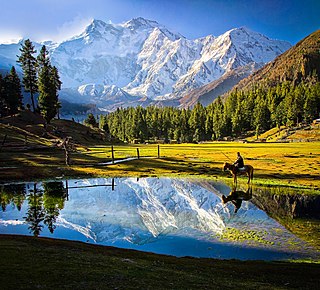
The Western Himalayas refers to the western half of the Himalayas, in northwestern India and northern Pakistan. Four of the five tributaries of the Indus River in Punjab rise in the Western Himalayas; while the fifth, the Sutlej cuts through the range after rising in Tibet.
















